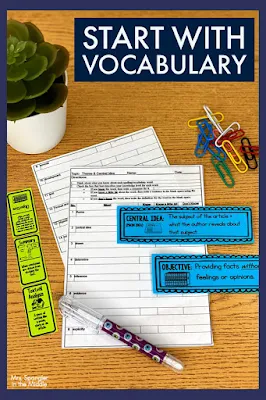This year, I am teaching 7th grade and according to our scope and sequence, the first thing we are meant to teach is "Citing Evidence and Analyzing Central Idea/Theme".
Can you see my students' eyes glaze over from where you are?
I'm not sure if it's just my students, but they seemed to have no recollection of even the most basic terms!
So, we started with vocabulary.
 |
| Get your own copy of this vocabulary worksheets, word wall cards and dominoes game by clicking here! |
Now that they seemed to know the definitions (again), we worked to find the central idea together through examining an article from NewsELA.
Even though the students seemed to understand what central idea is, they still had a hard time pulling it out of an article.
So I decided to make a recipe or formula to help them figure out exactly how to get to the central idea and supporting details. I did this by making a PowerPoint with some interactive guided notes (that I call Pixanotes) to differentiate the content and reach all my learners:
We used an article on sinkholes because we are reading the novel Tangerine by Edward Bloor, but really you can use any article with these four steps!
The steps are:
1. Read the article and pay attention to the text features and text structures to determine the subject of the article.
2. Ask yourself "What is the subject of the article and what does the author reveal about the subject?" (That's the central idea!)
3. Turn the central idea into a question.
4. Answer the question. The answers are the supporting details! (which leads to citing evidence!)
I was amazed at how many "lightbulbs" came on during this lesson! I think this is because they really don't know how to apply the definitions they have learned. It's kind of a lightbulb moment for me too, really - I guess as a teacher we think some things are obvious when they really aren't.
That's great news though! Now I know how to focus in on the "how" in terms of the standards I need to teach.
After we finished with content, then we practiced with some task cards. Some students played ZAP. and some played SCATTER. This way I could differentiate the processing of the content. Finally, we had a quiz.
Students who scored 80% or better were given an enrichment menu while students who scored less than 80% were given a reteach menu (labeled enhancement). Now I could differentiate the product too!
 |
| Get these menus by clicking here! |
I won't lie, it was a lot of work up front, but the results were worth it! Lucky for you, I've done all the work and you can get my unit with the PowerPoint, notes, quiz, menus and more by clicking here!
Thanks for stopping by!
There's more great ideas where this one came from!


